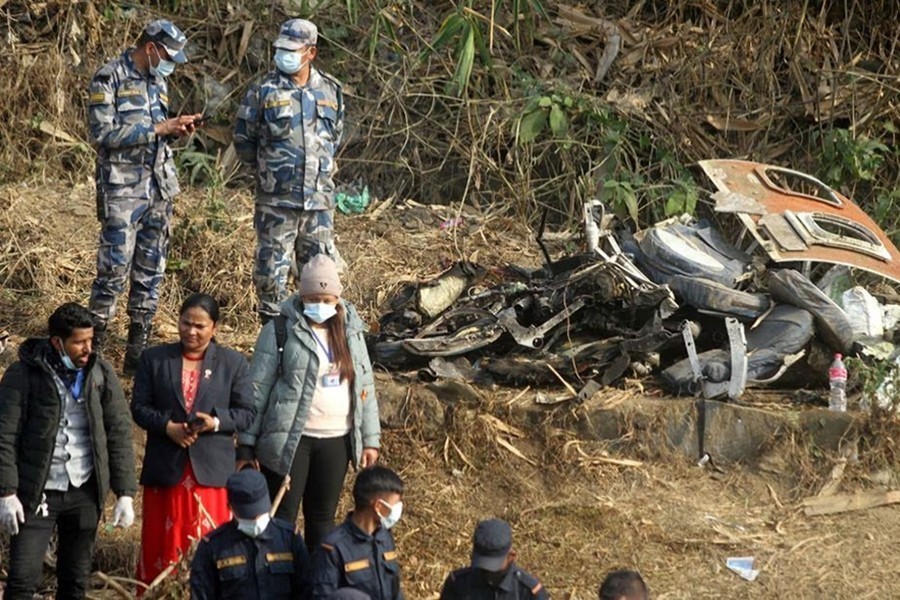Nepalese authorities on Tuesday began returning to families the bodies of plane crash victims and were sending the aircraft's data recorder to France for analysis as they try to determine what caused the country's deadliest air accident in 30 years.
The flight plummeted into a gorge on Sunday while on approach to the newly opened Pokhara International Airport in the foothills of the Himalayas, killing at least 70 of the 72 people aboard. Searchers found the cockpit voice recorder and flight data recorder on Monday, and combed through debris scattered down the 300-metre-deep (984-foot-deep) ravine in search of the two missing, who are presumed dead. One body was found earlier Tuesday.
The voice recorder would be analyzed locally, but the flight data recorder would be sent to France, said Jagannath Niraula, spokesperson for Nepal's Civil Aviation Authority. The aircraft's manufacturer, ATR, is headquartered in Toulouse.
The French air accident investigations agency confirmed it is taking part in the investigation, and its representatives were already on site, reports AP.
The twin-engine ATR 72-500t, operated by Nepal's Yeti Airlines, was completing the 27-minute flight from the capital, Kathmandu, to the resort city of Pokhara, 200 kilometers (125 miles) west.
It's still not clear what caused the crash, less than a minute's flight from the airport in light wind and clear skies.
Aviation experts say it appears that the turboprop went into a stall at low altitude on approach to the airport, but it is not clear why.
From a smartphone video shot from the ground seconds before the aircraft crashed, one can see the ATR 72 "nose high, high angle of attack, with wings at a very high bank angle, close to the ground," said Bob Mann, an aviation analyst and consultant.
"Whether that was due to loss of power, or misjudging aircraft's energy, direction or the approach profile, and attempting to modify energy or approach, that aircraft attitude would likely have resulted in an aerodynamic stall and rapid loss of altitude, when already close to the ground," he said in an email.
The aircraft was carrying 68 passengers, including 15 foreign nationals and four crew members. The foreigners included five Indians, four Russians, two South Koreans, and one each from Ireland, Australia, Argentina and France. Pokhara is the gateway to the Annapurna Circuit, a popular hiking trail in the Himalayas.
On Tuesday afternoon, over 150 people gathered at Tulsi Ghat, a cremation ground on the banks of the Seti River in Pokhara, to mourn Tribhuwan Paudel, a 37-year-old journalist and editor at a local newspaper, who died in the crash. As a priest lit the funeral pyre, close friends of Paudel came together to reminisce.
Rishikanta Paudel said Paudel always celebrated his successes. "He would cry with happiness whenever I did something good ... I still feel like he might call me any time now and ask how I am."
Bimala Bhandari, the chairperson for the Federation of Nepali Journalists in Kaski district, described Paudel as driven and passionate about the development of Pokhara.
"He was dearest to all journalists here because of his nature," said Badri Binod Pratik, a friend and journalist who taught Paudel. "The accident has taken him away from us ... I am crumbling since the day of the crash."
Funerals for other victims, many of whom were from the area, are expected in the coming days. They include a pharmaceutical marketing agent who was traveling to be with his sister as she gave birth, and a minister of a South Korean religious group who was going to visit the school he founded.
On Monday evening, hundreds of relatives and friends were still gathered outside a local hospital. Many consoled each other, while some shouted at officials to speed up the post mortems so they could take the bodies of their loved ones home for funerals.
Aviation expert Patrick Smith, who flies Boeing 757 and 767 aircraft and writes a column called "Ask the Pilot," cautioned that a lot of details are still not known about the crash, but said that the plane "appears to have succumbed to a loss of control at low altitude."
"One possibility is a botched response to an engine failure," he told The Associated Press in an e-mail.
The man who shot the smartphone footage of the plane's descent said it looked like a normal landing until the plane suddenly veered to the left.
"I saw that and I was shocked ... I thought that today everything will be finished here after it crashes, I will also be dead," said Diwas Bohora.
The type of plane involved, the ATR 72, has been used by airlines around the world for short regional flights since the late 1980s. Introduced by a French and Italian partnership, the aircraft model has been involved in several deadly accidents over the years. In Taiwan, two accidents involving ATR 72-500 and ATR 72-600 aircrafts in 2014 and 2015 led to the planes being grounded for a period.
Nepal, home to eight of the world's 14 highest mountains including Mount Everest, has a history of air crashes. Sunday's crash is Nepal's deadliest since 1992, when all 167 people aboard a Pakistan International Airlines plane were killed when it plowed into a hill as it tried to land in Kathmandu.
According to the Flight Safety Foundation's Aviation Safety database, there have been 42 fatal plane crashes in Nepal since 1946.
The European Union has banned airlines from Nepal from flying into the 27-nation bloc since 2013, citing weak safety standards. In 2017, the International Civil Aviation Organization cited improvements in Nepal's aviation sector, but the EU continues to demand administrative reforms.


